Berg J.M., Tymoczko J.L., Stryer L. Biochemistry
Подождите немного. Документ загружается.

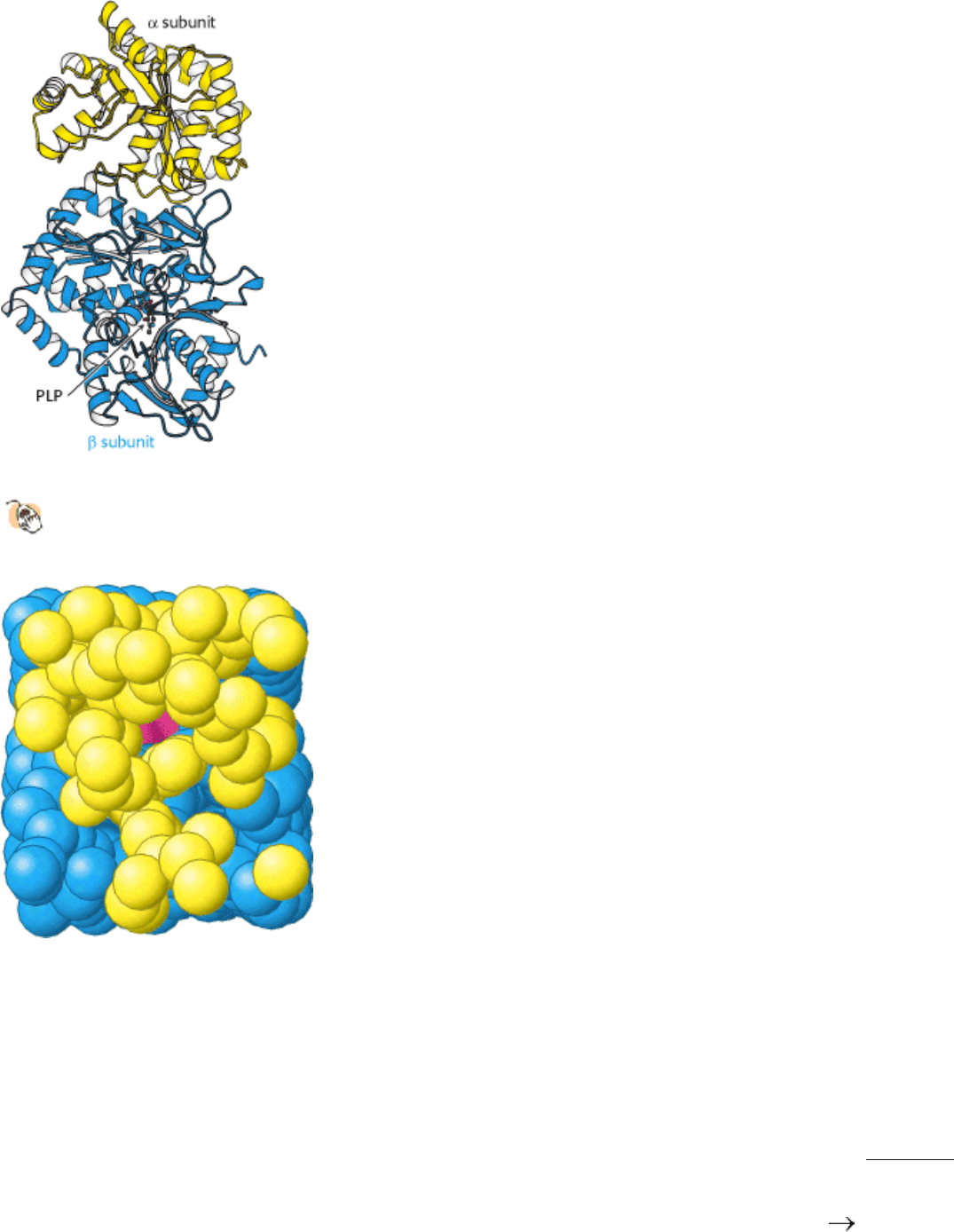
Figure 24.19. Structure of Tryptophan Synthetase.
The structure of the complex formed by one α subunit and one β
subunit. PLP is bound to the β subunit.
III. Synthesizing the Molecules of Life 24. The Biosynthesis of Amino Acids 24.2. Amino Acids Are Made from Intermediates of the Citric Acid Cycle and Other Major Pathways
Figure 24.20. Substrate Channeling. A 25-Å tunnel runs from the active site of the α subunit of tryptophan synthetase
(yellow) to the PLP cofactor (red) in the active site of the β subunit (blue).
III. Synthesizing the Molecules of Life 24. The Biosynthesis of Amino Acids
24.3. Amino Acid Biosynthesis Is Regulated by Feedback Inhibition
The rate of synthesis of amino acids depends mainly on the amounts of the biosynthetic enzymes and on their activities.
We now consider the control of enzymatic activity. The regulation of enzyme synthesis will be discussed in Chapter 31.
In a biosynthetic pathway, the first irreversible reaction, called the committed step, is usually an important regulatory
site. The final product of the pathway (Z) often inhibits the enzyme that catalyzes the committed step (A
B).

This kind of control is essential for the conservation of building blocks and metabolic energy. Consider the biosynthesis
of serine (Section 24.2.5). The committed step in this pathway is the oxidation of 3-phosphoglycerate, catalyzed by the
enzyme 3-phosphoglycerate dehydrogenase. The E. coli enzyme is a tetramer of four identical subunits, each comprising
a catalytic domain and a serine-binding regulatory domain (Figure 24.21). The regulatory domains of two subunits
interact to form a dimeric serine-binding regulatory unit so that the tetrameric enzyme contains two such regulatory
units. Each unit is capable of binding two serine molecules. The binding of serine to a regulatory site reduces the value
of V
max
for the enzyme; an enzyme bound to four molecules of serine is essentially inactive. Thus, if serine is abundant
in the cell, the enzyme activity is inhibited, and so 3-phosphoglycerate, a key building block that can be used for other
processes, is not wasted.
24.3.1. Branched Pathways Require Sophisticated Regulation
The regulation of branched pathways is more complicated because the concentration of two products must be accounted
for. In fact, several intricate feedback mechanisms have been found in branched biosynthetic pathways.
Feedback Inhibition and Activation.
Consider, for example, the biosynthesis of the amino acids valine, leucine, and isoleucine. A common intermediate,
hydroxyethyl thiamine pyrophosphate (hydroxyethyl-TPP; Section 17.1.1), initiates the pathways leading to all three of
these amino acids. Hydroxyethyl-TPP can react with α-ketobutyrate in the initial step for the synthesis of isoleucine.
Alternatively, hydroxyethyl-TPP can react with pyruvate in the committed step for the pathways leading to valine and
leucine. Thus, the relative concentrations of α-ketobutyrate and pyruvate determine how much isoleucine is produced
compared with valine and leucine. Threonine deaminase, the PLP enzyme that catalyzes the formation of α-ketobutyrate,
is allosterically inhibited by isoleucine (Figure 24.22). This enzyme is also allosterically activated by valine. Thus, this
enzyme is inhibited by the product of the pathway that it initiates and is activated by the end product of a competitive
pathway. This mechanism balances the amounts of different amino acids that are synthesized.
The regulatory domain in threonine deaminase is very similar in structure to the dimeric regulatory domain in 3-
phosphoglycerate dehydrogenase (Figure 24.23). In this case, the two half regulatory domains are fused into a single unit
with two differentiated amino acid-binding sites, one for isoleucine and the other for valine. Sequence analysis shows
that similar regulatory domains are present in other amino acid biosynthetic enzymes. The similarities suggest that
feedback-inhibition processes may have evolved by the linkage of specific regulatory domains to the catalytic domains of
biosynthetic enzymes.
Enzyme Multiplicity.
Sophisticated regulation can also evolve by duplication of the genes encoding the biosynthetic enzymes. For example,
the phosphorylation of aspartate is the committed step in the biosynthesis of threonine, methionine, and lysine. Three
distinct aspartokinases catalyze this reaction in E. coli, an example of a regulatory mechanism called enzyme multiplicity.
(Figure 24.24). The catalytic domains of these enzymes show approximately 30% sequence identity. Although the
mechanisms of catalysis are essentially identical, their activities are regulated differently: one enzyme is not subject to
feedback inhibition, another is inhibited by threonine, and the third is inhibited by lysine.
Cumulative Feedback Inhibition

The regulation of glutamine synthetase in E. coli is a striking example of cumulative feedback inhibition. Recall that
glutamine is synthesized from glutamate, NH
4
+
, and ATP. Glutamine synthetase consists of 12 identical 50-kd subunits
arranged in two hexagonal rings that face each other (Figure 24.25). Earl Stadtman showed that this enzyme regulates
the flow of nitrogen and hence plays a key role in controlling bacterial metabolism. The amide group of glutamine is a
source of nitrogen in the biosyntheses of a variety of compounds, such as tryptophan, histidine, carbamoyl phosphate,
glucosamine 6-phosphate, cytidine triphosphate, and adenosine monophosphate. Glutamine synthetase is cumulatively
inhibited by each of these final products of glutamine metabolism, as well as by alanine and glycine. In cumulative
inhibition, each inhibitor can reduce the activity of the enzyme, even when other inhibitors are bound at saturating
levels. The enzymatic activity of glutamine synthetase is switched off almost completely when all final products are
bound to the enzyme.
24.3.2. The Activity of Glutamine Synthetase Is Modulated by an Enzymatic Cascade
The activity of glutamine synthetase is also controlled by reversible covalent modification
the attachment of an AMP
unit by a phosphodiester bond to the hydroxyl group of a specific tyrosine residue in each subunit (Figure 24.26). This
adenylylated enzyme is less active and more susceptible to cumulative feedback inhibition than is the deadenylylated
form. The covalently attached AMP unit is removed from the adenylylated enzyme by phosphorolysis. The attachment of
an AMP unit is the final step in an enzymatic cascade that is initiated several steps back by reactants and immediate
products in glutamine synthesis.
The adenylation and phosphorolysis reactions are catalyzed by the same enzyme, adenylyl transferase. Sequence
analysis indicates that this adenylyl transferase comprises two homologous halves, suggesting that one half catalyzes the
adenylation reaction and the other half the phospholytic de-adenylation reaction. What determines whether an AMP unit
is added or removed? The specificity of adenylyl transferase is controlled by a regulatory protein (designated P or P
II
), a
trimeric protein that can exist in two forms, P
A
and P
D
(Figure 24.27). The complex of P
A
and adenylyl transferase
catalyzes the attachment of an AMP unit to glutamine synthetase, which reduces its activity. Conversely, the complex of
P
D
and adenylyl transferase removes AMP from the adenylylated enzyme.
This brings us to another level of reversible covalent modification. P
A
is converted into P
D
by the attachment of uridine
monophosphate to a specific tyrosine residue (Figure 24.28). This reaction, which is catalyzed by uridylyl transferase, is
stimulated by ATP and α-ketoglutarate, whereas it is inhibited by glutamine. In turn, the UMP units on P
D
are removed
by hydrolysis, a reaction promoted by glutamine and inhibited by α-ketoglutarate. These opposing catalytic activities are
present on a single polypeptide chain, homologous to adenylyl transferase, and are controlled so that the enzyme does
not simultaneously catalyze uridylylation and hydrolysis.
Why is an enzymatic cascade used to regulate glutamine synthetase? One advantage of a cascade is that it amplifies
signals, as in blood clotting and the control of glycogen metabolism (Sections 10.5.5 and 21.3.1). Another advantage is
that the potential for allosteric control is markedly increased when each enzyme in the cascade is an independent target
for regulation. The integration of nitrogen metabolism in a cell requires that a large number of input signals be detected
and processed. In addition, the regulatory protein P also participates in regulating the transcription of genes for glutamine
synthetase and other enzymes taking part in nitrogen metabolism. The evolution of a cascade provided many more
regulatory sites and made possible a finer tuning of the flow of nitrogen in the cell.
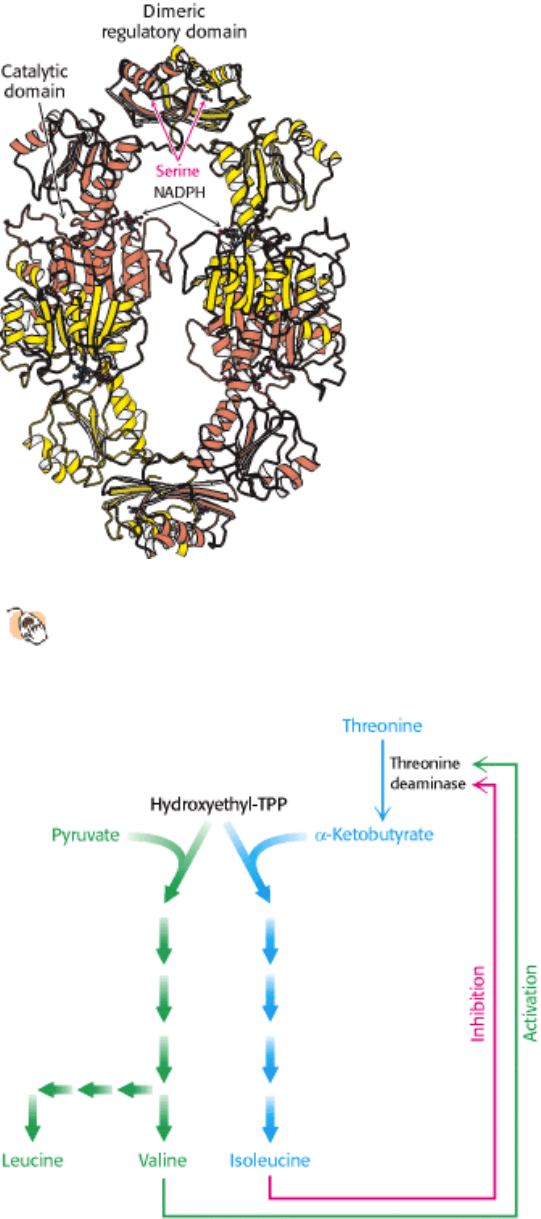
III. Synthesizing the Molecules of Life 24. The Biosynthesis of Amino Acids 24.3. Amino Acid Biosynthesis Is Regulated by Feedback Inhibition
Figure 24.21. Structure of 3-Phosphoglycerate Dehydrogenase.
This enzyme, which catalyzes the committed step in
the serine biosynthetic pathway, includes a serine-binding regulatory domain. Serine binding to this domain
reduces the activity of the enzyme.
III. Synthesizing the Molecules of Life 24. The Biosynthesis of Amino Acids 24.3. Amino Acid Biosynthesis Is Regulated by Feedback Inhibition
Figure 24.22. Regulation of Threonine Deaminase. Threonine is converted into α-ketobutyrate in the committed step
leading to the synthesis of isoleucine. The enzyme that catalyzes this step, threonine deaminase, is inhibited by
isoleucine and activated by valine, the product of a parallel pathway.

III. Synthesizing the Molecules of Life 24. The Biosynthesis of Amino Acids 24.3. Amino Acid Biosynthesis Is Regulated by Feedback Inhibition
Figure 24.23. A Recurring Regulatory Domain.
The regulatory domain formed by two subunits of 3-phosphoglycerate
dehydrogenase is structurally related to the single-chain regulatory domain of threonine deaminase. Sequence
analyses have revealed this amino acid-binding regulatory domain to be present in other enzymes as well.
III. Synthesizing the Molecules of Life 24. The Biosynthesis of Amino Acids 24.3. Amino Acid Biosynthesis Is Regulated by Feedback Inhibition
Figure 24.24. Domain Structures of Three Aspartokinases. Each catalyzes the committed step in the biosynthesis of a
different amino acid: (top) methionine, (middle) threonine, and (bottom) lysine. They have a catalytic domain in
common but differ in their regulatory domains.

III. Synthesizing the Molecules of Life 24. The Biosynthesis of Amino Acids 24.3. Amino Acid Biosynthesis Is Regulated by Feedback Inhibition
Figure 24.25. Structure of Glutamine Synthetase.
Glutamine synthetase consists of 12 identical subunits arranged in
two rings of six subunits. The active sites are indicated by the presence of manganese ions (two yellow spheres).
III. Synthesizing the Molecules of Life 24. The Biosynthesis of Amino Acids 24.3. Amino Acid Biosynthesis Is Regulated by Feedback Inhibition
Figure 24.26. Regulation by Adenylation. (A) A specific tyrosine residue in each subunit in glutamine synthetase is
modified by adenylation. (B) Adenylation of tyrosine is catalyzed by a complex of adenylyl transferase (AT) and one
form of a regulatory protein (P
A
). The same enzyme catalyzes deadenylation when it is complexed with the other form
(P
D
) of the regulatory protein.
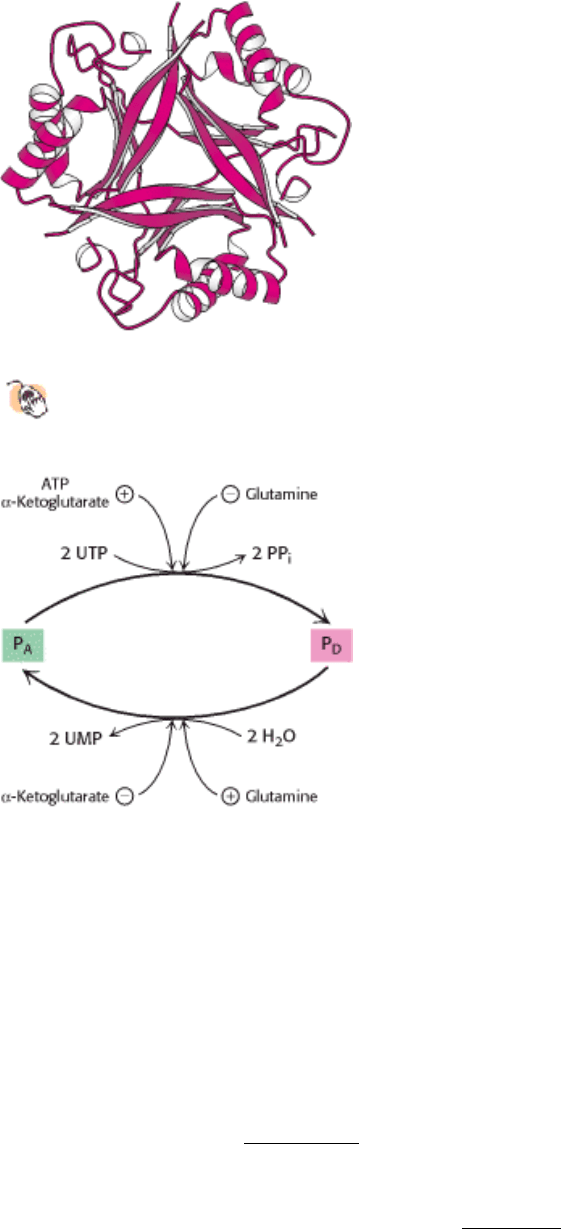
III. Synthesizing the Molecules of Life 24. The Biosynthesis of Amino Acids 24.3. Amino Acid Biosynthesis Is Regulated by Feedback Inhibition
Figure 24.27. Structure of the Regulatory Protein P.
This trimeric regulatory protein controls the modification of
glutamine synthetase.
III. Synthesizing the Molecules of Life 24. The Biosynthesis of Amino Acids 24.3. Amino Acid Biosynthesis Is Regulated by Feedback Inhibition
Figure 24.28. A Higher Level in the Regulatory Cascade of Glutamine Synthetase. P
A
and P
D,
the regulatory
proteins that control the specificity of adenylyl transferase, are interconvertible. P
A
is converted into P
D
by uridylylation,
which is reversed by hydrolysis. The enzymes catalyzing these reactions are regulated by the concentrations of metabolic
intermediates.
III. Synthesizing the Molecules of Life 24. The Biosynthesis of Amino Acids
24.4. Amino Acids Are Precursors of Many Biomolecules
In addition to being the building blocks of proteins and peptides, amino acids serve as precursors of many kinds of small
molecules that have important and diverse biological roles. Let us briefly survey some of the biomolecules that are
derived from amino acids (Figure 24.29).
Purines and pyrimidines are derived largely from amino acids. The biosynthesis of these precursors of DNA, RNA, and
numerous coenzymes will be discussed in detail in Chapter 25. The reactive terminus of sphingosine, an intermediate in
the synthesis of sphingolipids, comes from serine. Histamine, a potent vasodilator, is derived from histidine by
decarboxylation. Tyrosine is a precursor of the hormones thyroxine (tetraiodothyronine) and epinephrine and of melanin,
a complex polymeric pigment. The neurotransmitter serotonin (5-hydroxytryptamine) and the nicotinamide ring of NAD
+
are synthesized from tryptophan. Let us now consider in more detail three particularly important biochemicals derived
from amino acids.
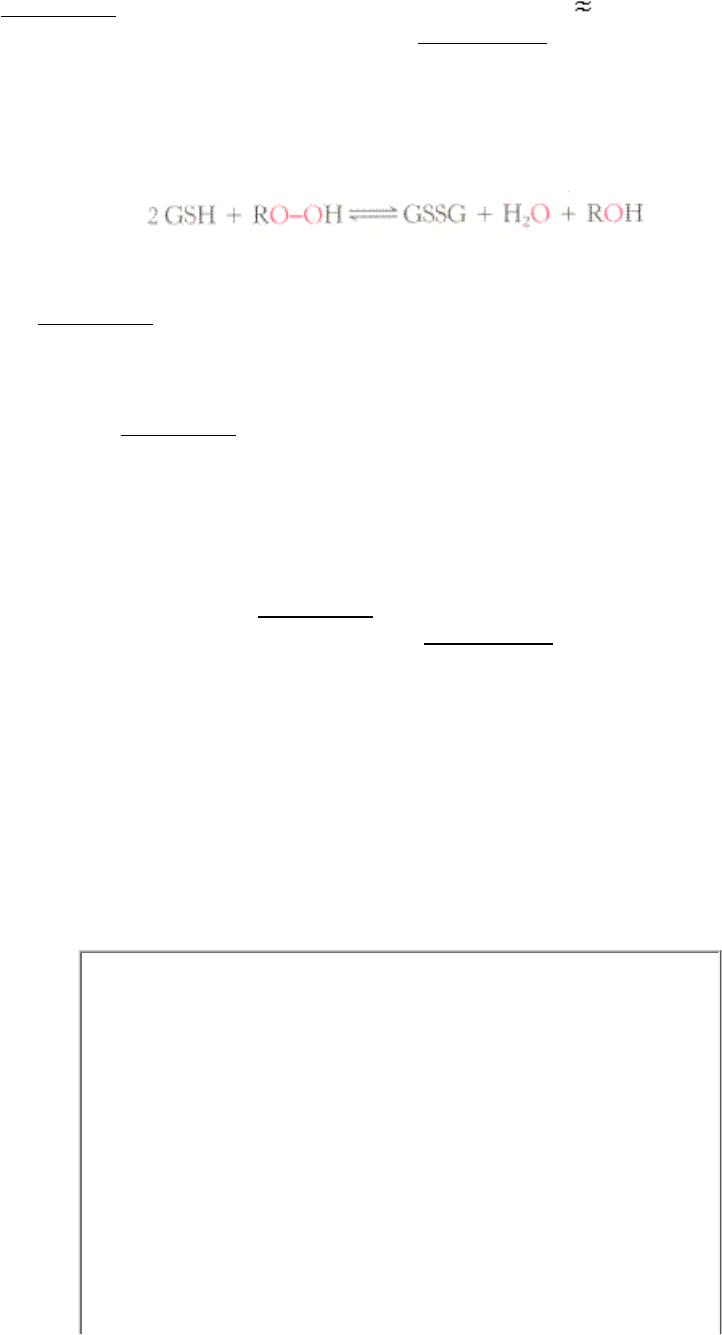
24.4.1. Glutathione, a Gamma-Glutamyl Peptide, Serves as a Sulfhydryl Buffer and an
Antioxidant
Glutathione, a tripeptide containing a sulfhydryl group, is a highly distinctive amino acid derivative with several
important roles (Figure 24.30). For example, glutathione, present at high levels ( 5 mM) in animal cells, protects red
cells from oxidative damage by serving as a sulfhydryl buffer (Section 20.5.1). It cycles between a reduced thiol form
(GSH) and an oxidized form (GSSG) in which two tripeptides are linked by a disulfide bond. GSSG is reduced to GSH
by glutathione reductase, a flavoprotein that uses NADPH as the electron source. The ratio of GSH to GSSG in most
cells is greater than 500. Glutathione plays a key role in detoxification by reacting with hydrogen peroxide and organic
peroxides, the harmful by-products of aerobic life.
Glutathione peroxidase, the enzyme catalyzing this reaction, is remarkable in having a modified amino acid containing a
selenium (Se) atom (Figure 24.31). Specifically, its active site contains the selenium analog of cysteine, in which
selenium has replaced sulfur. The selenolate (E-Se
-
) form of this residue reduces the peroxide substrate to an alcohol and
is in turn oxidized to selenenic acid (E-SeOH). Glutathione then comes into action by forming a selenosulfide adduct (E-
Se-S-G). A second molecule of glutathione then regenerates the active form of the enzyme by attacking the selenosulfide
to form oxidized glutathione (Figure 24.32).
24.4.2. Nitric Oxide, a Short-Lived Signal Molecule, Is Formed from Arginine
Nitric oxide (NO) is an important messenger in many vertebrate signal-transduction processes. This free-radical gas is
produced endogenously from arginine in a complex reaction that is catalyzed by nitric oxide synthase. NADPH and O
2
are required for the synthesis of nitric oxide (Figure 24.33). Nitric oxide acts by binding to and activating soluble
guanylate cyclase, an important enzyme in signal transduction (Section 32.3.3). This enzyme is homologous to adenylate
cyclase but includes a heme-containing domain that binds NO.
24.4.3. Mammalian Porphyrins Are Synthesized from Glycine and Succinyl Coenzyme
A
The involvement of an amino acid in the biosynthesis of the porphyrin rings of hemes and chlorophylls was first revealed
by the results of isotopiclabeling experiments carried out by David Shemin and his colleagues. In 1945, they showed that
the nitrogen atoms of heme were labeled after the feeding of [
15
N]glycine to human subjects (of whom Shemin was the
first), whereas the ingestion of [
15
N]glutamate resulted in very little labeling.
15N labeling: A pioneer's account
"Myself as a Guinea Pig
". . . in 1944, I undertook, together with David Rittenberg, an
investigation on the turnover of blood proteins of man. To this end I
synthesized 66 g of glycine labeled with 35 percent
15
N at a cost of
$1000 for the
15
N. On 12 February 1945, I started the ingestion of
the labeled glycine. Since we did not know the effect of relatively
large doses of the stable isotope of nitrogen and since we believed
that the maximum incorporation into the proteins could be achieved
by the administration of glycine in some continual manner, I
ingested 1 g samples of glycine at hourly intervals for the next 66

hours. . .. At stated intervals, blood was withdrawn and after proper
preparation the
15
N concentrations of different blood proteins were
determined."
-David Shemin
Bioessays 10(1989):30
Using
14
C, which had just become available, they discovered that 8 of the carbon atoms of heme in nucleated duck
erythrocytes are derived from the α-carbon atom of glycine and none from the carboxyl carbon atom. The results of
subsequent studies demonstrated that the other 26 carbon atoms of heme can arise from acetate. Moreover, the
14
C in
methyl-labeled acetate emerged in 24 of these carbons, whereas the
14
C in carboxyl-labeled acetate appeared only in the
other 2 (Figure 24.34).
This highly distinctive labeling pattern led Shemin to propose that a heme precursor is formed by the condensation of
glycine with an activated succinyl compound. In fact, the first step in the biosynthesis of porphyrins in mammals is the
condensation of glycine and succinyl CoA to form δ-aminolevulinate.
This reaction is catalyzed by δ-aminolevulinate synthase, a PLP enzyme present in mitochondria. Two molecules of δ -
aminolevulinate condense to form porphobilinogen, the next intermediate. Four molecules of porphobilinogen then
condense head to tail to form a linear tetrapyrrole in a reaction catalyzed by porphobilinogen deaminase. The enzyme-
bound linear tetrapyrrole then cyclizes to form uroporphyrinogen III, which has an asymmetric arrangement of side
chains. This reaction requires a cosynthase. In the presence of synthase alone, uroporphyrinogen I, the nonphysiologic
symmetric isomer, is produced. Uroporphyrinogen III is also a key intermediate in the synthesis of vitamin B
12
by
bacteria and that of chlorophyll by bacteria and plants (Figure 24.35).
The porphyrin skeleton is now formed. Subsequent reactions alter the side chains and the degree of saturation of the
porphyrin ring (see Figure 24.34). Coproporphyrinogen III is formed by the decarboxylation of the acetate side chains.
The desaturation of the porphyrin ring and the conversion of two of the propionate side chains into vinyl groups yield
protoporphyrin IX. The chelation of iron finally gives heme, the prosthetic group of proteins such as myoglobin,
hemoglobin, catalase, peroxidase, and cytochrome c. The insertion of the ferrous form of iron is catalyzed by
ferrochelatase. Iron is transported in the plasma by transferrin, a protein that binds two ferric ions, and stored in tissues
inside molecules of ferritin. The large internal cavity ( 80 Å in diameter) of ferritin can hold as many as 4500 ferric
ions (Section 31.4.2).
The normal human erythrocyte has a life span of about 120 days, as was first shown by the time course of
15
N in
Shemin's own hemoglobin after he ingested
15
N-labeled glycine. The first step in the degradation of the heme group is
the cleavage of its α-methene bridge to form the green pigment biliverdin, a linear tetrapyrrole. The central methene
bridge of biliverdin is then reduced by biliverdin reductase to form bilirubin, a red pigment (Figure 24.36). The changing
color of a bruise is a highly graphic indicator of these degradative reactions.
24.4.4. Porphyrins Accumulate in Some Inherited Disorders of Porphyrin Metabolism
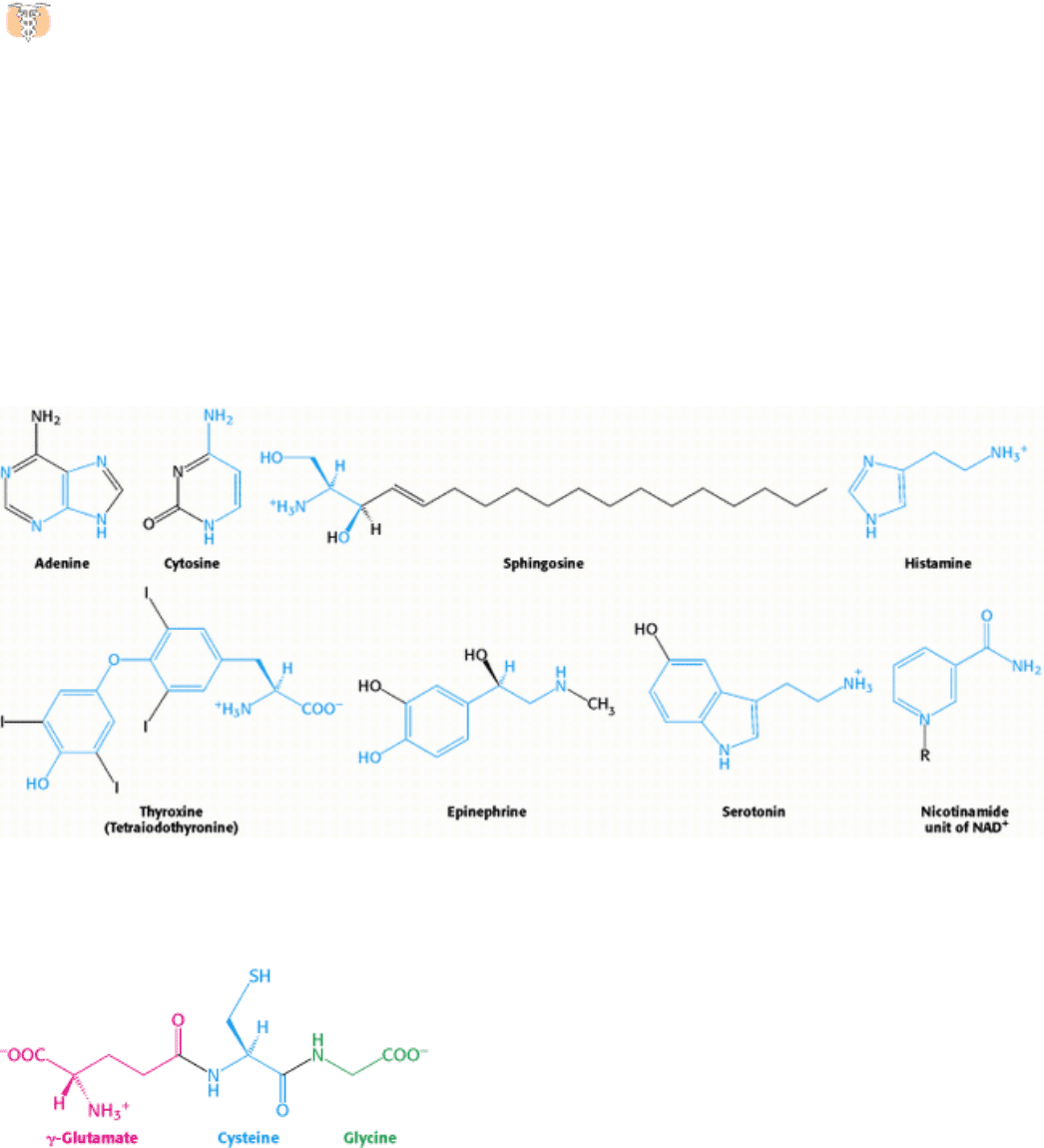
Porphyrias are inherited or acquired disorders caused by a deficiency of enzymes in the heme biosynthetic
pathway. Porphyrin is synthesized in both the erythroblasts and the liver, and either one may be the site of a
disorder. Congenital erythropoietic porphyria, for example, prematurely destroys eythrocytes. This disease results from
insufficient cosynthase. In this porphyria, the synthesis of the required amount of uroporphyrinogen III is accompanied
by the formation of very large quantities of uroporphyrinogen I, the useless symmetric isomer. Uroporphyrin I,
coproporphyrin I, and other symmetric derivatives also accumulate. The urine of patients having this disease is red
because of the excretion of large amounts of uroporphyrin I. Their teeth exhibit a strong red fluorescence under
ultraviolet light because of the deposition of porphyrins. Furthermore, their skin is usually very sensitive to light because
photoexcited porphyrins are quite reactive. Acute intermittent porphyria is the most prevalent of the porphyrias affecting
the liver. This porphyria is characterized by the overproduction of porphobilinogen and δ -aminolevulinate, which results
in severe abdominal pain and neurological dysfunction. The "madness" of George III, King of England during the
American Revolution, is believed to have been due to this porphyria.
III. Synthesizing the Molecules of Life 24. The Biosynthesis of Amino Acids 24.4. Amino Acids Are Precursors of Many Biomolecules
Figure 24.29. Selected Biomolecules Derived from Amino Acids. The atoms contributed by amino acids are shown in
blue.
III. Synthesizing the Molecules of Life 24. The Biosynthesis of Amino Acids 24.4. Amino Acids Are Precursors of Many Biomolecules
Figure 24.30. Glutathione. This tripeptide consists of a cysteine residue flanked by a glycine residue and a glutamate
residue that is linked to cysteine by an isopeptide bond between glutamate's side-chain carboxylate group and cysteine's
amino group.
